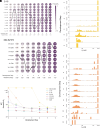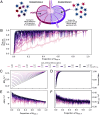Retrospective SARS-CoV-2 human antibody development trajectories are largely sparse and permissive
- PMID: 39841142
- PMCID: PMC11789010
- DOI: 10.1073/pnas.2412787122
Retrospective SARS-CoV-2 human antibody development trajectories are largely sparse and permissive
Abstract
Immunological interventions, like vaccinations, are enabled by the predictive control of humoral responses to novel antigens. While the development trajectories for many broadly neutralizing antibodies (bnAbs) have been measured, it is less established how human subtype-specific antibodies develop from their precursors. In this work, we evaluated the retrospective development trajectories for eight anti-SARS-CoV-2 Spike human antibodies (Abs). To mimic the immunological process of BCR selection during affinity maturation in germinal centers (GCs), we performed deep mutational scanning on anti-S1 molecular Fabs using yeast display coupled to fluorescence-activated cell sorting. Focusing only on changes in affinity upon mutation, we found that human Ab development pathways have few mutations which impart changes in monovalent binding dissociation constants and that these mutations can occur in nearly any order. Maturation pathways of two bnAbs showed that while they are only slightly less permissible than subtype-specific Abs, more development steps on average are needed to reach the same level of affinity. Many of the subtype-specific Abs had inherent affinity for antigen, and these results were robust against different potential inferred precursor sequences. To evaluate the effect of differential affinity for precursors on GC outcomes, we adapted a coarse-grained affinity maturation model. This model showed that antibody precursors with minimal affinity advantages rapidly outcompete competitors to become the dominant clonotype.
Keywords: antibodies; antibody development; deep mutational scanning.
Conflict of interest statement
Competing interests statement:T.A.W. serves on the scientific advisory board at Metaphore and Alta Resource Technologies. The other authors have no interests to declare.
Figures





Similar articles
-
Novel Monoclonal Antibodies and Recombined Antibodies Against Variant SARS-CoV-2.Front Immunol. 2021 Aug 30;12:715464. doi: 10.3389/fimmu.2021.715464. eCollection 2021. Front Immunol. 2021. PMID: 34539645 Free PMC article.
-
Affinity maturation of SARS-CoV-2 neutralizing antibodies confers potency, breadth, and resilience to viral escape mutations.Immunity. 2021 Aug 10;54(8):1853-1868.e7. doi: 10.1016/j.immuni.2021.07.008. Epub 2021 Jul 30. Immunity. 2021. PMID: 34331873 Free PMC article.
-
A paradigm shift in simulating affinity maturation to elicit broadly neutralizing antibodies.Front Immunol. 2025 Jul 1;16:1627674. doi: 10.3389/fimmu.2025.1627674. eCollection 2025. Front Immunol. 2025. PMID: 40666529 Free PMC article. Review.
-
IgV somatic mutation of human anti-SARS-CoV-2 monoclonal antibodies governs neutralization and breadth of reactivity.JCI Insight. 2021 May 10;6(9):e147386. doi: 10.1172/jci.insight.147386. JCI Insight. 2021. PMID: 33769311 Free PMC article.
-
SARS-CoV-2 journey: from alpha variant to omicron and its sub-variants.Infection. 2024 Jun;52(3):767-786. doi: 10.1007/s15010-024-02223-y. Epub 2024 Mar 30. Infection. 2024. PMID: 38554253 Free PMC article. Review.
Cited by
-
Replaying germinal center evolution on a quantified affinity landscape.bioRxiv [Preprint]. 2025 Jun 5:2025.06.02.656870. doi: 10.1101/2025.06.02.656870. bioRxiv. 2025. PMID: 40661619 Free PMC article. Preprint.
References
MeSH terms
Substances
Grants and funding
LinkOut - more resources
Full Text Sources
Medical
Miscellaneous

